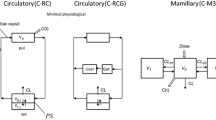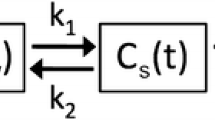Abstract
Pulmonary uptake of basic amine xenobiotics such as lidocaine may influence the onset of drug effect and ameliorate toxicity. To date, pharmacokinetic analysis of pulmonary drug uptake has been only semiquantitative and ill-suited for relating pharmacodynamics to pharmacokinetics or jar estimating the time course of the fraction of drug dose residing in the lung during a single pass. We have developed recirculatory models in an experiment in which lidocaine was injected into the right atrium simultaneously with markers of intravascular space (indocyanine green) and total body water (antipyrine): this was followed by rapid arterial and mixed venous blood sampling. Such models are interpretable physiologically and are capable of characterizing the kinetics of the pulmonary uptake of lidocaine in addition to peripheral tissue distribution and elimination. The apparent pulmonary tissue volume of lidocaine (39 ml/kg) was nearly ninefold greater than that of antipyrine (4.5 ml/kg). The recirculatory model characterized both arterial and mixed venous data, but the latter data were not essential for estimating lidocaine's pulmonary disposition either before or after recirculation of drug was evident.
Similar content being viewed by others
REFERENCES
C. Post. Studies on the pharmacokinetic function of the lung with special reference to lidocaine. Acta Pharmacol. Toxicol. 44(Suppl. 1):1–53 (1979).
R. E. Howell and P. N. Lanken. Pulmonary accumulation of propranolol in vivo: Sites and physiochemical mechanism. J. Pharmacol. Exp. Ther. 263:130–135 (1992).
D. L. Roerig, K. J. Kotrly, E. J. Vucins, S. B. Ahlf, C. A. Dawson, and J. P. Kampine. First pass uptake of fentanyl, meperidine, and morphine in the human lung. Anesthesiology 67:466–472 (1987).
P. M. Bokesch, A. R. Castaneda, G. Ziemer, and J. M. Wilson. The influence of a right-to-left cardiac shunt on lidocaine pharmacokinetics. Anesthesiology 67:739–744 (1987).
C. Post, R. G. Andersson, A. Ryrfeldt, and E. Nilsson. Transport and binding of lidocaine by lung slices and perfused lung of rats. Acta Pharmacol. Toxicol. 43:156–163 (1978).
K. Taeger, E. Weninger, F. Schmelzer, M. Adt, N. Franke, and K. Peter. Pulmonary kinetics of fentanyl and alfentanil in surgical patients. Br. J. Anaesth. 61:425–434 (1988).
W. L. Chiou. Potential pitfalls in the conventional pharmacokinetic studies: Effects of the initial mixing of drug in blood and the pulmonary first-pass elimination. J. Pharmacokin. Biopharm. 7:527–536 (1979).
T. C. Krejcie, T. K. Henthorn, C. A. Shanks, and M. J. Avram. A recirculatory pharmacokinetic model describing the circulatory mixing, tissue distribution and elimination of antipyrine in dogs. J. Pharmacol. Exp. Ther. 269:609–616 (1994).
Y. F. Huang, R. N. Upton, L. E. Mather, and W. B. Runciman. An assessment of methods for sampling blood to characterize rapidly changing blood drug concentrations. J. Pharm. Sci. 80:847–851 (1991).
D. M. Grasela, M. L. Rocci, Jr, and P. H. Vlasses. Experimental impact of assay-dependent differences in plasma indocyanine green concentration determinations. J. Pharmacokin. Biopharm. 15:601–613 (1987).
T. K. Henthorn, M. J. Avram, T. C. Krejcie, C. A. Shanks, A. Asada, and D. A. Kaczynski. Minimal compartmental model of circulatory mixing of indocyanine green. Am. J. Physiol. 262:H903–H910 (1992).
K. Ahmad and F. Medzihradsky. Distribution of lidocaine in blood and tissue after single doses and steady infusion. Res. Commun. Chem. Pathol. Pharmacol. 2:813–828 (1971).
T. C. Krejcie, J. A. Jacquez, M. J. Avram, C. U. Niemann, C. A. Shanks, and T. K. Henthorn. Use of parallel Erlang density functions to analyze first-pass pulmonary uptake of multiple indicators in dogs. J. Pharmacokin. Biopharm. 24:569–588 (1996).
K. L. Zierler. In W. F. Hamilton (ed.), Handbook of Physiology, Section 2, Circulation. Vol. 1. American Physiological Society, Washington, DC. 1962, pp. 585–615.
Y. W. Zhen, S. E. Cross, and M. S. Roberts. Influence of physicochemical parameters and perfusate flow rate on the distribution of solutes in the isolated perfused rat hindlimb determined by the impulse-response technique. J. Pharm. Sci. 84:1020–1027 (1995).
B. S. Berman, E. Shahn, and M. J. Weiss. The routine fitting of kinetic data to models: A mathematical formalism for digital computers. Biophys. J. 2:275–287 (1962).
S. Siegel. Nonparametric Statistics for the Behavioral Sciences, McGraw-Hill, New York, 1956.
P. Caldini, S. Permutt, J. A. Waddell, and R. L. Riley. Effect of epinephrine on pressure, flow, and volume relationships in the systemic circulation of dogs. Circ. Res. 34:606–623 (1974).
K. L. Brigham, L. H. Ramsey, J. D. Snell, and C. R. Merritt, III. On defining the pulmonary extravascular water volume. Circ. Res. 29:385–397 (1971).
R. M. Effros, G. R. Mason, E. Reid, L. Graham, and P. Silverman. Diffusion of labeled water and lipophilic solutes in the lung. Microvasc. Res. 29:45–55 (1985).
C. M. Metzler. In M. Rowland and G. T. Tucker (eds.), international Encyclopedia of Pharmacology and Therapeutics. Section 122, Pharmacokinetics: Theory and Methodology, Pergamon, New York, 1986, pp. 407–420.
W. O. Cua, G. Basset, F. Bouchonnet, R. A. Garrick, G. Saumon, and F. P. Chinard. Endothelial and epithelial permeabilities to antipyrine in rat and dog lungs. Am. J. Physiol. 258:H1321–H1333 (1990).
L. Jorfeldt, D. H. Lewis, J. B. Lofstrom, and C. Post. Lung uptake of lidocaine in healthy volunteers. Acta Anaesth. Scand. 23:567–574 (1979).
W. L. Chiou. The phenomenon and rationale of marked dependence of drug concentration on blood sampling site. Implications in pharmacokinetics, pharmacodynamics, toxicology and therapeutics (Part I). [Review]. Clin. Pharmacokin. 17:175–199 (1989).
W. L. Chiou. The phenomenon and rationale of marked dependence of drug concentration on blood sampling site. Implications in pharmacokinetics, pharmacodynamics, toxicology and therapeutics (Part II). [Review]. Clin. Pharmacokin. 17:275–290 (1989).
G. Clausen, A. Hope, and K. Aukland. Partition of 125I-iodoantipyrine among erythrocytes, plasma, and renal cortex in the dog. Acta Physiol. Scand. 107:63–68 (1979).
C. A. Dawson, C. W. Christensen, D. A. Rickaby, J. H. Linehan, and M. R. Johnston. Lung damage and pulmonary uptake of serotonin in intact dogs. J. Appl. Physiol. 58:1761–1766 (1985).
N. Benowitz, R. P. Forsyth, K. L. Melmon, and M. Rowland. Lidocaine disposition kinetics in monkey and man. II. Effects of hemorrhage and sympathomimetic drug administration. Clin. Pharmacol. Ther. 16:99–109 (1974).
K. Tanaka, Y. Oda, A. Asada, M. Fujimori, and Y. Funae. Metabolism of lidocaine by rat pulmonary cytochrome P450. Biochem. Pharmacol. 47:1061–1066 (1994).
D. L. Roerig, R. R. Dahl, C. A. Dawson, and R. I. Wang. Effect of plasma protein binding on the uptake of methadone and diazepam in the isolated perfused rat lung. Drug Metab. Dispos. 12:536–542 (1984).
G. S. Sedek, T. I. Ruo, M. C. Frederiksen, J. W. Frederiksen, S. R. Shih, and A. J. Atkinson, Jr. Splanchnic tissues are a major part of the rapid distribution spaces of inulin, urea and theophylline. J. Pharmacol. Exp. Ther. 251:1026–1031 (1989).
D. R. Wada and D. S. Ward. The hybrid model: A new pharmacokinetic model for computer-controlled infusion pumps. IEEE Trans. Biomed. Eng. 41:134–142 (1994).
E. M. Renkin. Effects of blood flow on diffusion kinetics in isolated perfused hindlegs of cats. Am. J. Physiol. 183:125–136 (1955).
S. Bjorkman, D. R. Wada, D. R. Stanski, and W. F. Ebling. Comparative physiological pharmacokinetics of fentanyl and alfentanil in rats and humans based on parametric single-tissue models. J. Pharmacokin. Biopharm. 22:381–410 (1994).
W. F. Ebling, D. R. Wada, and D. R. Stanski. From piecewise to full physiologic pharmacokinetic modeling: applied to thiopental disposition in the rat. J. Pharmacokin. Biopharm. 22:259–292 (1994).
T. G. Coleman, R. D. Manning, Jr, R. A. Norman, Jr, and A. C. Guyton. Dynamics of water isotope distribution. Am. J. Physiol. 223:1371–1375 (1972).
A. Rescigno and J. S. Beck. The use and abuse of models. J. Pharmacokin. Biopharm. 15:327–344 (1987).
T. C. Krejcie, T. K. Henthorn, C. U. Niemann, C. Klein, D. K. Gupta, W. B. Gentry, C. A. Shanks, and M. J. Avram. Recirculatory pharmacokinetic models of markers of blood, extracellular fluid, and total body water administered concomitantly. J. Pharmacol. Exp. Ther. 278:1051–1057 (1996).
Author information
Authors and Affiliations
Rights and permissions
About this article
Cite this article
Krejcie, T.C., Avram, M.J., Brooks Gentry, W. et al. A Recirculatory Model of the Pulmonary Uptake and Pharmacokinetics of Lidocaine Based on Analysis of Arterial and Mixed Venous Data from Dogs. J Pharmacokinet Pharmacodyn 25, 169–190 (1997). https://doi.org/10.1023/A:1025780012960
Published:
Issue Date:
DOI: https://doi.org/10.1023/A:1025780012960




